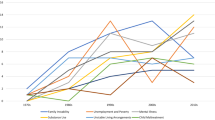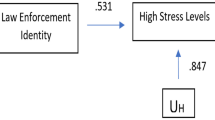Abstract
The increased pressures which have been placed upon correctional institutions in the 1980’s have made the retention of quality correctional officers imperative. Yet many of these officers find prison work to be an unsatisfying experience. This paper attempts to measure levels of alienation among correctional officers and identify factors which may be related to its occurrence.
The amount of alienation experienced by 126 correctional officers at a Western state prison was measured utilizing Dean’s Alienation Scale. Alienation levels were found to be related primarily to institutional, and opposed to non-institutional, variables. The implications for correctional administration are discussed.
Similar content being viewed by others
References
Berger, R. (1978). Public image of corrections.California Youth Authority Quarterly 31: 2–17.
Blalock, H. (1979).Social Statistics. New York: McGraw-Hill Book Company.
Carroll, L. (1980). The frustrated hacks, in B. Crouch (ed.)The Keepers. Springfield, IL: Charles Thomas, pp. 302–322.
Cullen, F., Link, B., Wolfe, N. and Frank, J. (1985). The social dimensions of correctional officer stress.Justice Quarterly 2: 505–533.
Dean, D. (1961). Alienation: Its meaning and measurement.American Sociological Review 26: 753–758.
Duffee, D. (1974). The correctional officer subculture and organizational change.Journal of Research in Crime and Delinquency 4: 155–172.
Hajda, J. (1961). Alienation and integration of student intellectuals.American Sociological Review 26: 758–77.
Hepburn, J. (1985). Power in coercive organizations: A study of prison guards,Criminology 23: 145–164.
— and Albonetti, C. (1980). Role conflict in correctional institutions: An empirical examination of the treatment-custody dilemma among correctional staff.Criminology 17: 455–459.
- and Jurik, N. (1986). Individual attributes, occupational conditions, and job satisfaction of correction security officers. Presented at the American Society of Criminology, Atlanta, October.
Jacobs, J. (1978). What prison guards think — A profile of the Illinois force.Crime and Delinquency 24: 185–196.
Kinsell, L. and Sheldon, R. (1981). A survey of officers at a mediun security prison.Corrections Today 43: 40–43.
Lombardo, L. (1981).Guards Imprisoned — Correctional Officers at Work. New York: Elsevier North-Holland.
Miller, D. (1970).Handbook of Research Design and Social Measurement. New York: McKay Publishing Company.
Mottaz, C. (1983). Alienation among police officers.Journal of Police Science and Administration 11: 23–30.
National Advisory Commission on Criminal Justice Standards and Goals (1973).Report on Corrections. Washington, DC: U.S. Printing.
Norusis, M. (1983).SPSSX Introductory Statistics Guide. New York McGraw-Hill Book Company.
Poole, E. and Regoli, R. (1983). Professionalism, role conflict, work alienation, and anomia: A look at prison management.The Social Science Journal 20: 63–70.
— (1981). Alienation in prison: An examination of the work relationships of prison guards.Criminology 19: 251–270.
— (1980a). Examining the impact of professionalism upon cynicism, role conflict, and work alienation among prison guards.Criminal Justice Review 5: 57–65.
— (1980b). Role stress, custody orientation, and disciplinary actions: A study of prison guards.Criminology 18: 215–226.
Seeman, R. (1959). On the meaning of alienation.American Sociological Review 24: 783–791.
Seybolt, J. and Gruenfeld, L. (1976). The discriminant validity of work alienation and work satisfaction measures.Journal of Occupational Psychology 49: 193–204.
Toch, H. and Klofas, J. (1982). Alienation and a desire for job enrichment among correctional officers.Federal Probation Quarterly 1: 35–44.
Walters, S. (1988a). Alienating Factors in the Correctional Officer’s Environment. Presented at the Academy of Criminal Justice Sciences, San Francisco, CA, April.
— (1988b). Correctional officers’perceptions of powerlessness.Journal of Crime and Justice 11: 47–59.
Webb, G. and Morris, D. (1978).Prison Guards — The Culture and Perspective of an Occupational Group. Austin, TX: Coker Books.
Whitehead, J. and Lindquist, C. (1986). Correctional officers’ job burnout: A path model.Journal of Research in Crime and Delinquency 23: 23–42.
Wicks, R. (1981).Guard! Society’s professional Prisoner. Houston, TX: Gulf Publishing Company.
Author information
Authors and Affiliations
Rights and permissions
About this article
Cite this article
Walters, S. Alienation and the correctional officer: A multivariate analysis. AJCJ 16, 50–62 (1991). https://doi.org/10.1007/BF02899748
Issue Date:
DOI: https://doi.org/10.1007/BF02899748




